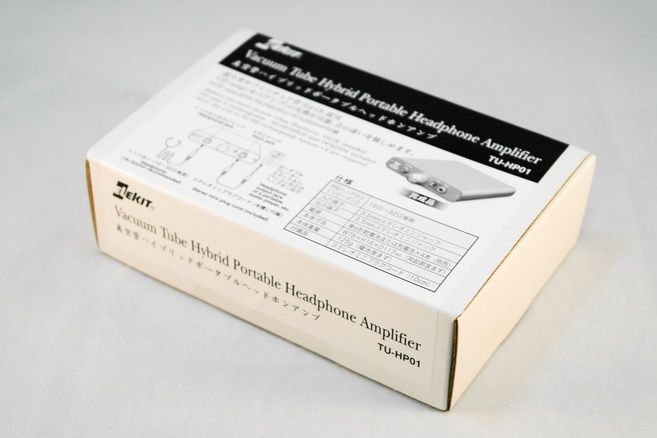
Spec
Vacuum tube: 2 x Raytheon 6418
Frequency response: 10Hz - 65kHz
Recommended Headphone impedance: 16ohm - 32ohm
Power supply: 4 x AAA or 4 x AAA Ni-MH rechargeable batteries
Battery life: Approx.10 hours
Dimensions: W78 x H16 x D117 mm (excl. projections)
Weight: 125g (excl. batteries)

Accessories and Build Quality
The TU-HP01 comes in a fairly plain white box that one might confuse it to be a DIY kit at first look. But unlike most of Elekit’s offerings, this little tube hybrid is fully finished and only requires 4 AAA batteries to come to live. Inside the box, you will find the amp, a manual (in Japanese or English, depends on where you get the amp), a short 3.5mm interconnecting cable, an extra face plate, a hex key as well as an extra opamp.
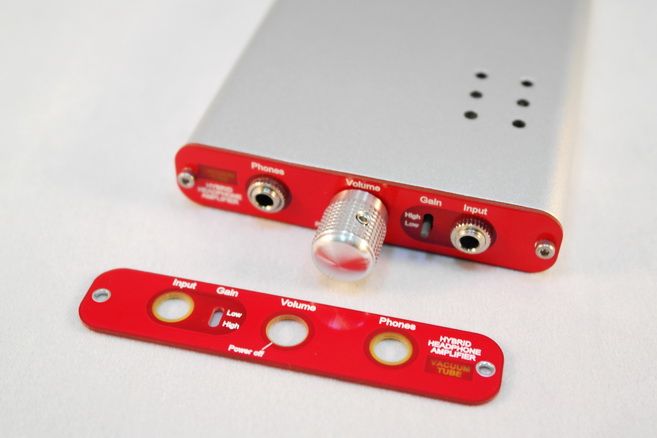
Though the top of the housing has six holes, the vacuum tubes (2 x Raytheon 6418) used in the TU-HP01 don’t actually heat up (or light up) at all so they are mostly there for aesthetically reason. There is a small orange LED just underneath the tubes that will light up to give you the impression of a ‘tube grow’. Since there is no heat issue on the amp, you can cover the holes up without affecting the performance. Elekit includes an extra upside-down face plate that will let you choose which way you want the top side of the amp to be – again, this is mostly for aesthetically reason, and probably lesser chance for any dust getting into the amp if the holes is facing downward / inward. The battery bay can be accessed by unscrewing the back plate without any special tool. But if you want to swap the opamp, you need to use the included hex key to open up the front. While the amp is fairly slim, it is however not small. It has a footprint just bigger than an O2 and half as tall. I’ll call that a little bigger than a typical full-size portable.
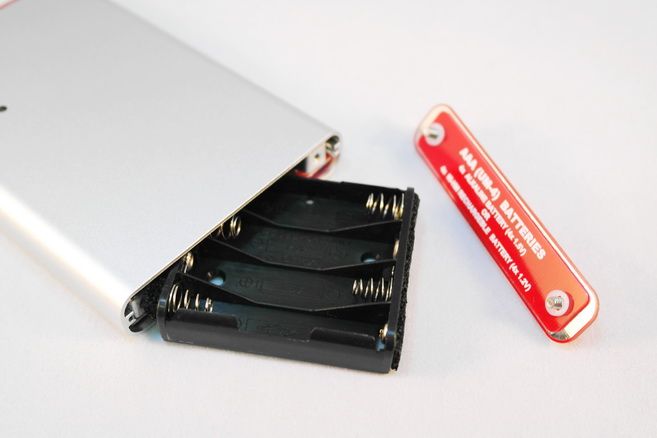
TU-HP01 comes with JRC MUSES8820 pre-installed, plus an extra TI OPA2604 if you feel like opamp-rolling. I have done some simple measurement on the socket and it seems to be running on +/-4.5V. So any opamp that can operate on that voltage should work. Some of Elekit’s suggestions of alternative opamp include LME49720, MUSES8920, MUSES02, NJM4580, NJM4560, and NJM3414 (we’ll cover opamp rolling on later discussion).
Overall the amp has excellent build quality. The design and finishing is probably among the best I have even seen on any portable amp - a likely reflection of the Japanese meticulous nature to their products.

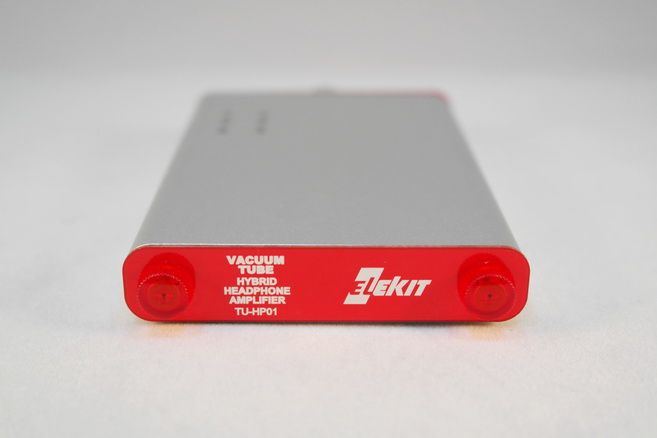
Gain, Hiss, EMI and Microphonics
There are two gain settings on the TU-HP01. The low setting is about -2.2dB while the high setting is about +4dB. The limited range of gain means it really won’t drive high impedance headphone to a very loud volume, which is probably why Elekit only suggesting headphone impedance range of 16ohm ~ 32ohm. However, I think it should be fine with anything less than 150ohm (if not a bit more) as long as it has high sensitivity. There is almost no click-and-pop during startup or shutdown. Hiss is however quite noticeable on sensitive IEM though it doesn’t change with volume. EMI is also very noticeable, annoying but not excessively loud.
Beside hiss and EMI, there is also some detectable microphonics from the tube, especially if there is any kind of impact (even a soft one, like tapping a finger on the housing lightly) on or near the amp. While it isn’t loud by any mean, it can be picked up in quiet passage of the music with sensitive headphone. To make sure microphonics is as low as possible, you need to be sure that the amp is turned on gently and allows it to sit on the desktop without any disturbance. If you notice the microphonics starts to increase, turning the amp off and on again will help to tame it down.
While hiss and microphonics are both masked quite well during music playback, they are definitely detectable. So even though Elekit suggested using low impedance (16ohm to 32ohm) headphones with the TU-HP01, it would be best to avoid using too sensitive a headphone on the amp.
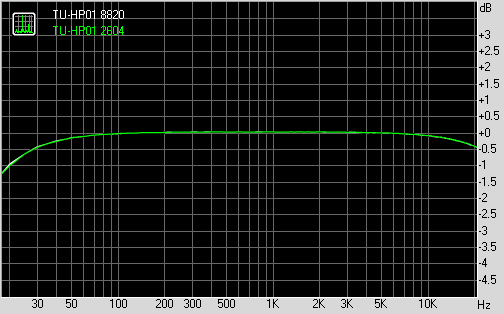
As I have said in my iFi Audio iTube impression, tube gears are always associated with noise and harmonic, especially when it comes to measurement. The TU-HP01 is no exception. While the RMAA result isn’t too bad, it certainly isn’t quite as nice looking as a full solid state amp. THD and IMD are around 0.2~0.3% - while not too bad on their own, they are significant higher than the reference 0.02% of the O2. Frequency response is mostly flat with a tiny roll off at both ends. There is an almost inaudible -0.5dB from 10kHz to 20kHz and a minor -1dB from 100Hz to 20Hz. Output impedance is measured and calculated to be about 4 ohm, which isn’t too bad. Current output isn’t particularly high, but it should be enough for not demanding headphone. Though the TU-HP01 has a roll-able opamp design, the measureable difference between different opamp is actually quite minimum. One thing I took notice during the measurement is that high input level tends to increase distortion level on the amp more significantly, which is understandable given the amp is running on 4 AAA batteries and could clip easier than amp that runs on high voltage. While actual listening doesn’t quite reveal any significant distortion, it is advisable to keep the input lower than a full scale 2Vrms if you can. If you are using an iPod with its 0.55Vrms line-out, then it shouldn’t be any problem.
Subjectively, at least with the default MUSES8820 installed, TU-HP01 doesn’t come out as a colored sounding amp at first impression. If anything, it is hard to tell that if it is more ‘tube’ or ‘solid-state’ sounding, if you believe in such a classification. The one thing that can be sure is that it is quite a beautifully sounding amp. Volume matched to the O2 with a pair of RE-0, the most noticeable difference between them is that TU-HP01 brings out more background detail to the front, making it a richer and more textured presentation. While that’s a phenomenon I have observed on a few tube gears in the past, the TU-HP01 doesn’t do it in very euphonic or romantic way. Rather it is more subtle, or should I say in a less ‘tubish’ fashion. A more minor difference between the two is that TU-HP01 is slightly more laidback in presentation, pushing everything just a hair further away and a bit more specious.
Beyond those, TU-HP01 is almost every bit comparable to O2 in sound quality, or any top quality portable in the same price bucket.
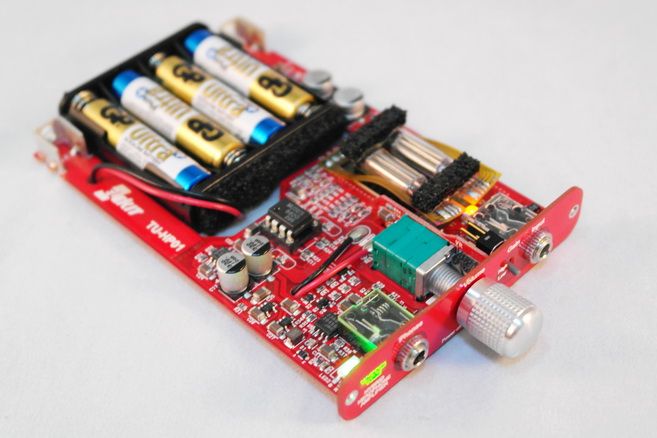
Opamp Rolling
While the above observation is done with the default MUSES8820, the amp does come with an extra OPA2604 and is compatible to opamp that can run on +/4.5V. So with the 8820 as reference, here are the impressions of some opamp I have tried in TU-HP01:
MUSES8820 – neutral to warm, well bodied and textured.
MUSES8920 – similar to 8820, but a tiny bit sharper and not as weighty.
MUSES02 – a refined and wider sounding 8820, excellently balanced with a hint of warm.
LM4562 – airy and open, most ‘solid-state’ sounding but not quite textured.
OPA2604 – tubish, warm and weighty sound.
AD8066 – fairly neutral, slightly sharp on treble
AD8397 – neutral, fairly rounded and nothing stands out
OPA2209 – similar to AD8066, more dynamic but also grainier
Surprisingly, the included OPA2604 turns TU-HP01 into a much more ‘tube’ sounding amp than I thought that amp is capable of. It is warm and very rich, if not just a bit slow. Another more ‘distinguishable’ opamp is the LM4562, which sounds almost too clean to a fault. The best sounding opamp is no doubt the MUSES02. It retains the same signature as 8820, but more refined and better layered, giving a grander and more specious presentation. Other opamp I tried sound quite decent in the amp as well, but fail to impress in any major way. Overall, I’ll suggest stick to the MUSE8820 as a general good performer that is quite suitable for different music genres or upgrade to the MUSES02 if you can.
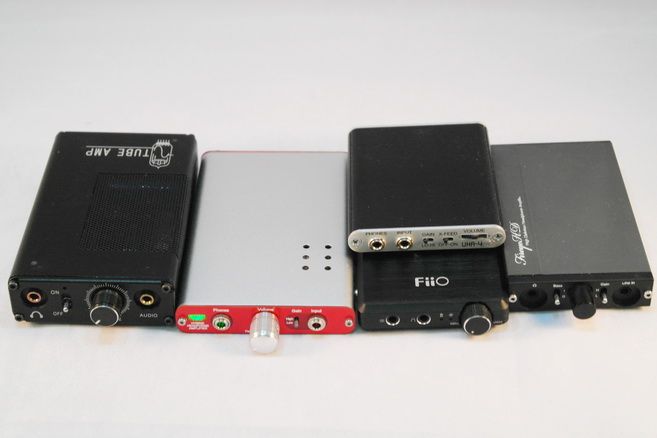
Size comparison (from left): Tube Amp BL-2, TU-HP01, Leckerton Audio UHA-4, FiiO E12, FireStone Audio FireyeHD
In Sum…
Despite its flaws, I’ll still consider TU-HP01 an excellent amp with both a beautiful finish and a beautiful sound. It is not suitable for headphone that is very demanding, either in current or voltage, and definitely not for those who can’t stand any hiss or microphonics. It is, in other words, not quite a one-size-fits-all type of portable amp that will do everything right. But if you can live with those flaws, it is still a lovely amp to own, or at least worth a listen to.
A thank to both Elekit Japan and VKMusic.ca for arranging the sample.





